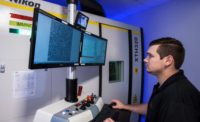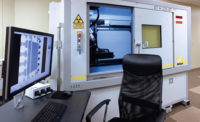Like other metrology technologies, X-ray CT systems must be traceably calibrated to give true metrological performance. Although technical committees are in the process of drawing up EU and ASME calibration standards, there currently is no internationally recognized standardized procedure for calibrating X-ray CT equipment. Instead, calibration must be derived and traced from another metrology method that does have such a standard, for example, a coordinate measuring machine (CMM).
There are currently two main methods of calibrating CT data at present:
- Combined CMM and CT systems
- Traceable calibration pieces.
We recommend using traceable calibration pieces, a lower-cost, simpler and more flexible calibration technique than combining CMM and CT systems in one.
Users of the combined calibration method must first purchase a system consisting of both an X-ray CT system and a CMM—a relatively expensive proposition. Because the CMM is part of the system, its electronics must be protected from the X-rays. For this reason the CMM cannot be used when the X-ray CT system is in use. This reduces overall system flexibility and can complicate inspection routines.
The combined calibration method relies on the CMM to find a physical surface based on CMM settings before location of a surface based on the threshold of the X-ray CT scan. These two readings must then be calibrated to each other before the system can be used. The technique treats internal and external surfaces identically, and thus fails to account for beam hardening or scattered X-rays.
Combining use of X-ray CT and CMM not only is relatively expensive and inflexible; it can also lead to compromises in manipulator positioning because the CMM must be shielded from X-rays. Thus combined systems are more complex and require additional trained operators and infrastructure.
The Preferred Method
In comparison, the other calibration method is relatively low-cost and simple. It relies on having a traceable calibration piece consisting of a number of spheres, chosen to have scale and X-ray properties similar to those of the test piece.
Measuring the calibration samples with a calibrated tool such as a CMM allows users to derive the center-to-center distances of the spheres. The X-ray threshold used to determine surface position in the X-ray CT volume data is irrelevant to the center-to-center distances. Thus users can calculate voxel size in the CT data with accuracy of approximately 0.1%, more accurately than system calibration of approximately 1%. The only caveat here is required use of spheres—use of a linear threshold dimension would compromise accuracy.
Users can then scale the CT data exactly so that it matches actual part dimensions and set the voxel size of the 3-D model to the value found from the traceable calibration. When combined with a true local surface determination, this will give a traceable calibrated 3-D CT model.
Users need not own a CMM. An external CMM or similar metrology equipment can be used to traceably measure the calibration pieces. Measurement can be performed offline at any certified lab or equivalent at regular intervals. The X-ray system can be used to take the CT as required, and the CMM used for calibration is available to make other measurements of other parts at the same time.
Also, the method treats both the traceable calibration piece and the test object in the same way—that is, the surface is found from the CT scan. This approach provides confidence that the same surface has been located. Internal and external surfaces are found using local thresholds and gradients, minimizing or negating the effect of beam hardening and scattered X-rays.
There’s also something to be said for having one apparatus designed to do a single job and do it well. In our preferred method, the X-ray CT system performs no functions that are not key to fast, accurate industrial computed tomography. Systems require no precision granite bed or large arm like a CMM would, so mass is lower. This results in faster and more accurate measurement.




